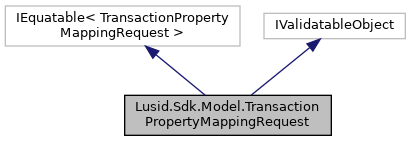TransactionPropertyMappingRequest
More...
◆ TransactionPropertyMappingRequest() [1/2]
| Lusid.Sdk.Model.TransactionPropertyMappingRequest.TransactionPropertyMappingRequest |
( |
| ) |
|
|
inlineprotected |
◆ TransactionPropertyMappingRequest() [2/2]
| Lusid.Sdk.Model.TransactionPropertyMappingRequest.TransactionPropertyMappingRequest |
( |
string |
propertyKey = default(string), |
|
|
string |
mapFrom = default(string), |
|
|
Object |
setTo = default(Object) |
|
) |
| |
|
inline |
Initializes a new instance of the TransactionPropertyMappingRequest class.
- Parameters
-
| propertyKey | Uniquely identifies the property definition and consists of a Domain, Scope and Code. (required). |
| mapFrom | The Property Key of the Property to map from.. |
| setTo | A pointer to the Property being mapped from.. |
◆ Equals() [1/2]
| override bool Lusid.Sdk.Model.TransactionPropertyMappingRequest.Equals |
( |
object |
input | ) |
|
|
inline |
Returns true if objects are equal
- Parameters
-
| input | Object to be compared |
- Returns
- Boolean
◆ Equals() [2/2]
◆ GetHashCode()
| override int Lusid.Sdk.Model.TransactionPropertyMappingRequest.GetHashCode |
( |
| ) |
|
|
inline |
Gets the hash code
- Returns
- Hash code
◆ ToJson()
| virtual string Lusid.Sdk.Model.TransactionPropertyMappingRequest.ToJson |
( |
| ) |
|
|
inlinevirtual |
Returns the JSON string presentation of the object
- Returns
- JSON string presentation of the object
◆ ToString()
| override string Lusid.Sdk.Model.TransactionPropertyMappingRequest.ToString |
( |
| ) |
|
|
inline |
Returns the string presentation of the object
- Returns
- String presentation of the object
◆ MapFrom
| string Lusid.Sdk.Model.TransactionPropertyMappingRequest.MapFrom |
|
getset |
◆ PropertyKey
| string Lusid.Sdk.Model.TransactionPropertyMappingRequest.PropertyKey |
|
getset |
Uniquely identifies the property definition and consists of a Domain, Scope and Code.
Uniquely identifies the property definition and consists of a Domain, Scope and Code.
◆ SetTo
| Object Lusid.Sdk.Model.TransactionPropertyMappingRequest.SetTo |
|
getset |
A pointer to the Property being mapped from.
A pointer to the Property being mapped from.
The documentation for this class was generated from the following file:
- /home/docs/checkouts/readthedocs.org/user_builds/lusid-sdk-csharp/checkouts/latest/sdk/Lusid.Sdk/Model/TransactionPropertyMappingRequest.cs
